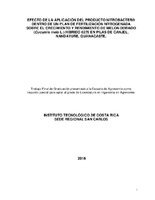Efecto de la aplicación del producto NITROBACTER® dentro de un plan de fertilización nitrogenada sobre el crecimiento y rendimiento de melón dorado (Cucumis melo L.) hibrido 6276 en pilas de canjel, Nandayure, Guanacaste
Resumen
This research was conducted at the Finca Agroexportaciones Canjel SA in Pilas de Canjel Nadayure. The process evaluated the effect on the development of the golden melon crop, 6276 hybrid; as part of the product Nitrobacter. This is based on nitrogen-fixing bacteria, incorporated into a plan of nitrogen fertilization. There were three treatments applied, two of them had the same dose of Nitrobacter, with different doses of nitrogen in order to establish a 55%, 85% and 100% of nitrogen fertilization. It was conducted in three batches of 3600 m2 each, which were duly divided into six plots each with a different treatment. Evaluations were performed during one growing season, which included the months of February to April 2016.
The variance analysis shows significant differences between treatments for dry weight of the aerial part of the crop and also for the total dry weight. There were no significant differences for the number of leaves per plant, number of guides per plant and leaf area between treatments. It was determined that the number of days in which the highest growth of the fruit goes from 35 to 47 DDT, with increases up to 100% of its weight. The content and nutritional value of the crop at 35 DDT, does not present significant differences between treatments, showing that the product does have a positive or negative influence overall.
There were no significant differences for the performance’s variable when compared between treatments. Therefore, treatment number three becomes the best option, introducing the fertilization at a lower cost compared to other treatments. The use of the product Nitrobacter, can reduce the use of nitrogen fertilizers, increasing the crop yield and reducing the cost of fertilization.
Descripción
Trabajo Final de Graduación (Licenciatura en Ingeniería en Agronomía). Instituto Tecnológico de Costa Rica. Escuela de Agronomía. 2016


